
Agronomy
RCRT in Upland Rice: Varietal trial in upland rice during 2006-2010 (5 years) showed that RCPL 1-117 (4.90±0.72 t/ha) recorded the highest grain yield, followed by RCPL 1-115 (4.49±0.95 t/ha) and RCPL 1-116 (3.45±0.43 t/ha).
RCRT in Lowland Rice: Varietal trial on lowland paddy during 2006-2010 (5 years) showed that the highest yield was recorded in TRC-87-251 (5.14 ± 0.45 t/ha), closely followed by IET -18564 (4.75 ± 0.74 t/ha), RCM-13 (4.62 ± 0.67 t/ha), and RCM-22 (4.09 ± 1.11 t/ha).
RCRT in Aromatic Paddy: Varietal trial on aromatic paddy during 2006-2010 (5 years) indicated that the highest yield was recorded in IET-16313 (5.47 ± 0.65 t/ha) closely followed by IET-16332 (4.74 ± 0.92 t/ha) and Sahsarang (4.54 ± 0.61 t/ha).
13 no of lowland paddy varieties were also evaluated for their performance in Nagaland condition. Among the varieties, IET-16313 recorded the highest yield (5.56 t/h) which was followed by IET-18572 (5.23 t/ha).
RCRT in Lowland Rice: Varietal trial on lowland paddy during 2006-2010 (5 years) showed that the highest yield was recorded in TRC-87-251 (5.14 ± 0.45 t/ha), closely followed by IET -18564 (4.75 ± 0.74 t/ha), RCM-13 (4.62 ± 0.67 t/ha), and RCM-22 (4.09 ± 1.11 t/ha).
RCRT in Aromatic Paddy: Varietal trial on aromatic paddy during 2006-2010 (5 years) indicated that the highest yield was recorded in IET-16313 (5.47 ± 0.65 t/ha) closely followed by IET-16332 (4.74 ± 0.92 t/ha) and Sahsarang (4.54 ± 0.61 t/ha).
13 no of lowland paddy varieties were also evaluated for their performance in Nagaland condition. Among the varieties, IET-16313 recorded the highest yield (5.56 t/h) which was followed by IET-18572 (5.23 t/ha).
Varietal Evaluation Trials in Groundnut: The trials in 2008-2010 (3 years) on Groundnut revealed that the maximum yield was recorded in FESEG-10 (3.17±0.12 t/ha) followed by NRCG CS-148 (3.09±0.02 t/ha) and GG-7(3.01±0.07 t/ha).
Varietal Evaluation Trials on Linseed under Rainfed Condition: Under AICRP on linseed during 2006-2009 (4 years), the evaluation results showed that line IVT(R)-90113 exhibited the highest grain yield (0.76±0.24 t/ha), followed by line IVT(R)-90101 (0.68±0.37 t/ha) and IVT(R)-90103 (0.62±0.33 t/ha).
Varietal Evaluation Trials on Linseed under Irrigated Condition: Under AICRP on linseed during 2006-2009 (4 years), evaluation results showed that line IVT (I) - 90212 exhibited highest grain yield (0.93±0.83 t/ha), followed by line IVT (I) - 90209 (0.89±0.58 t/ha) and IVT (I)-90202 (0.89±0.71 t/ha).
Varietal Evaluation of Rapeseed and Mustard under Rainfed Condition: The evaluation results during 2007-2010 (4 years) showed that the maximum yield was recorded in TS-38 (1.00±0.15t/ha), followed by TS-36 (0.83±0.10 t/ha) and M-27 (0.60±0.16 t/ha).
Varietal Evaluation Trials on Linseed under Rainfed Condition: Under AICRP on linseed during 2006-2009 (4 years), the evaluation results showed that line IVT(R)-90113 exhibited the highest grain yield (0.76±0.24 t/ha), followed by line IVT(R)-90101 (0.68±0.37 t/ha) and IVT(R)-90103 (0.62±0.33 t/ha).
Varietal Evaluation Trials on Linseed under Irrigated Condition: Under AICRP on linseed during 2006-2009 (4 years), evaluation results showed that line IVT (I) - 90212 exhibited highest grain yield (0.93±0.83 t/ha), followed by line IVT (I) - 90209 (0.89±0.58 t/ha) and IVT (I)-90202 (0.89±0.71 t/ha).
Varietal Evaluation of Rapeseed and Mustard under Rainfed Condition: The evaluation results during 2007-2010 (4 years) showed that the maximum yield was recorded in TS-38 (1.00±0.15t/ha), followed by TS-36 (0.83±0.10 t/ha) and M-27 (0.60±0.16 t/ha).
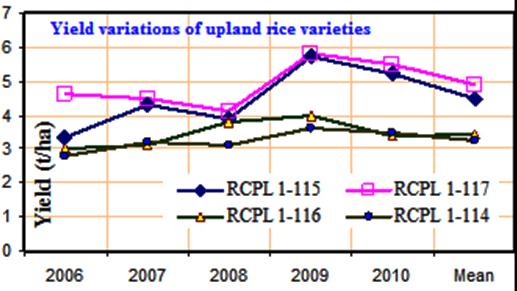
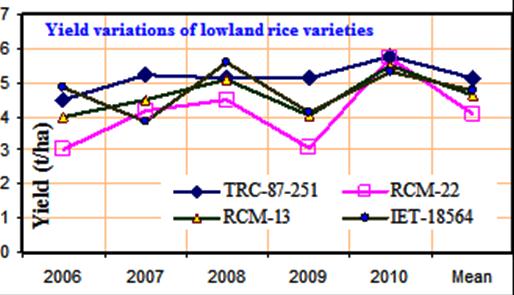
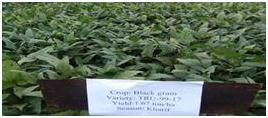
Evaluation of Black Gram Varieties: 15 varieties of black gram were evaluated for their yield potential and results showed that the highest yield was recorded with variety KU-8-613 (1.73 t/ha), followed by KU-8- 518 (1.67 t/ha) and TRU 99- 17 (1.67 t/ha).
Evaluation of Green Gram Varieties: 15 varieties of green gram were evaluated for their yield potential and results showed that the highest yield was recorded with variety KM-8-228 (0. the highest yield was recorded with variety KM-8-228 (0.57 t/ha), KM-8-102 (0.57 t/ha), followed by KM-8-228 (0.55 t/ha).
Integrated Nutrient Management in RCM-9 Paddy Variety: INM experiment on RCM-9 rice variety during 2006-2010 (5 years) was carried in split plot design and results showed grain yield was highest (3.92±0.51 t/ha) with application of crop residue+vermicompost+ bio-fertilizers, followed bio-fertilizers (3.77±0.61 t/ha), vermicompost (3.64±0.58 t/ha), and crop residue (3.42±0.51 t/ha). Similarly, in various fertility levels, grain yield was the highest (3.99±0.52 t/ha) with the application of 75% NPK, followed by with 100% NPK (3.95±0.48 t/ha), 50% NPK (3.67±0.65 t/ha), and control (3.35±0.54 t/ha).
Evaluation of Green Gram Varieties: 15 varieties of green gram were evaluated for their yield potential and results showed that the highest yield was recorded with variety KM-8-228 (0. the highest yield was recorded with variety KM-8-228 (0.57 t/ha), KM-8-102 (0.57 t/ha), followed by KM-8-228 (0.55 t/ha).
Integrated Nutrient Management in RCM-9 Paddy Variety: INM experiment on RCM-9 rice variety during 2006-2010 (5 years) was carried in split plot design and results showed grain yield was highest (3.92±0.51 t/ha) with application of crop residue+vermicompost+ bio-fertilizers, followed bio-fertilizers (3.77±0.61 t/ha), vermicompost (3.64±0.58 t/ha), and crop residue (3.42±0.51 t/ha). Similarly, in various fertility levels, grain yield was the highest (3.99±0.52 t/ha) with the application of 75% NPK, followed by with 100% NPK (3.95±0.48 t/ha), 50% NPK (3.67±0.65 t/ha), and control (3.35±0.54 t/ha).
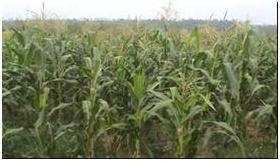
Integrated Nutrient Management in Maize (var. Vijay composite): INM experiment in maize during 2006-2010 (5 years) was carried in split plot design and results showed that the highest grain yield was observed with application of crop residue + vermicompost + bio-fertilizers (2.25±0.22 t/ha) followed by with bio-fertilizers (2.04±0.24t/ha), vermicompost (2.02±0.25t/ha), and crop residue (1.62±0.20 t/ha). In various fertility levels, the grain yield was the highest with the application of 75% NPK (2.34±0.24 t/ha), followed by with 100% NPK (2.31±0.26 t/ha), 50% NPK (1.96±0.31 t/ha), and control (1.34±0.13 t/ha).
INM Trial on Dwarf Pea (var. Azad): INM experiment conducted in rabi season of 2010-11 and 2011-12 on dwarf pea revealed that the maximum grain yield (1.20 t/ha) was recorded under treatment combination of 100% IN + 50% ON followed by 100% NPK + 50% Norganic,100% Norganic+50% NPK and 100% Norganic (.88 t/ha). The treatment combination of Biofertilizer+ micronutrient showed that seed inoculations with biofertilizer and application of micronutrient (zinc) recorded higher grain yield (1.08 t/ha) over control (0.66 t/ha).
Effect of Fertility Level and Seeding Rate on Linseed (var. Neelam) under Rainfed Condition: Experimental results during rabi season of 2010-11 and 2011-12 showed that the maximum seed yield of (0.89 t/ha) was realized with fertility level 90-60-60-45 NPKS kg/ha in variety Neelam. The maximum seed yield (0.85 t/ha) was recorded with the plant density of 35 kg/ha followed by 30 kg/ha (0.851 t/ha) and 30 kg/ha (0.75 t/ha).
Response of Fertility Levels on toria [Brassica campestris var. toria]: Experimental results during rabi season of 2010-11 and 2011-12 showed that the maximum seed yield of 1.12 t/ha was realized with the fertility level of 150% NPK followed by 125% (1.00 t/ha) NPK and 100% NPK (0.89 t/ha). Among the varieties, maximum seed yield (1.10 t/ha) was recorded in TS-38 followed by TS-36 (0.98 t/ha) and lowest with M-27 (0.70 t/ha).
Effect of Fertility Level and Seeding Rate on Linseed (var. Neelam) under Rainfed Condition: Experimental results during rabi season of 2010-11 and 2011-12 showed that the maximum seed yield of (0.89 t/ha) was realized with fertility level 90-60-60-45 NPKS kg/ha in variety Neelam. The maximum seed yield (0.85 t/ha) was recorded with the plant density of 35 kg/ha followed by 30 kg/ha (0.851 t/ha) and 30 kg/ha (0.75 t/ha).
Response of Fertility Levels on toria [Brassica campestris var. toria]: Experimental results during rabi season of 2010-11 and 2011-12 showed that the maximum seed yield of 1.12 t/ha was realized with the fertility level of 150% NPK followed by 125% (1.00 t/ha) NPK and 100% NPK (0.89 t/ha). Among the varieties, maximum seed yield (1.10 t/ha) was recorded in TS-38 followed by TS-36 (0.98 t/ha) and lowest with M-27 (0.70 t/ha).
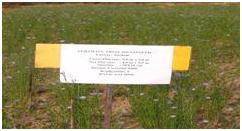
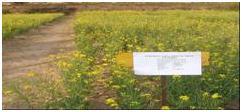
Effect of levels of lime application on growth, yield and quality of rice bean varieties: This field experiment was carried out at Institute Research Farm during the kharif season of 2011-12 and 2012-13. The experiment was laid out in split- plot design with three replications and comprising four levels of lime viz. control, 0.2, 0.4 and 0.6 t ha-1 were allotted to main plot where, four varieties of rice bean i.e. RBS -16, RBS-53, PRR-2 and RCRB-4 allotted to sub-plots. Lime application @ 0.6 t/ha recorded significantly higher yield attributes and yield of the rice bean followed by 0.4 and 0.2 t/ha. In case of the varieties, RBS-53 recorded significantly higher yield attributes and yield of the crop as compared to the other varieties.

Effects of crop establishment methods and nutrient management on production potential of rice: This field experiment was carried out in the Institute Research Farm during the kharif season of 2011-12. Three crop establishment methods, viz. system of rice intensification (SRI), integrated crop management (ICM) and conventional rice culture (CRC) were allotted to the main plot. Five treatments of fertility level, i.e. control, 100% RDF, 100 % RDF + crop residues, 100 % RDF ON and 100 % RDF ON + crop residues were allotted to the sub-plots; where ON represents organic nitrogen (120 kg/ha) through farm yard manure. The results revealed that in crop establishment methods, SRI recorded significantly the highest yield attributes and yield followed by ICM, and CRC recorded significantly the lowest yield attributes and yield of the crop. In case of fertility levels, 100 % RDF + Crop residues recorded significantly the highest yield attributes and yield of the crop followed by 100 % RDF, 100 % RDF ON + Crop residues as compared to control.
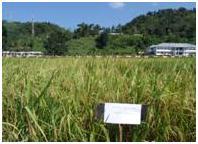
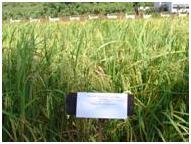
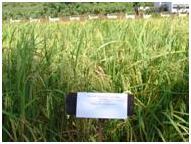
Effect of date of sowing, seeding rate and integrated nutrient management on production potential of summer mungbean (var. TS-1): Experiment was carried out in Research Farm in summer season of 2011-12 and 2012-13, laid out in split-split plot design with three replications. Two dates of sowing viz. 5th and 15th April were allotted to the main plot and four seed rates of 20, 25, 30 and 35 kg/ha in the sub-plot. Results revealed that 5th April sowing date recorded significantly higher yield attributes and yield of crop. In case of seed rate, with the increasing in seeding rate correspondingly increased the yield; but reverse in case of yield attributes. However, maximum yield was recorded with the highest seed rate due to a higher plant density of 35 kg ha-1. In case of fertility level, 100% IN + 50 % ON recorded significantly the highest yield attributes and finally highest yield followed by 100 % RDF.
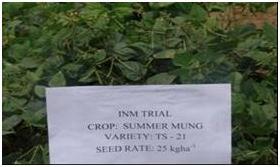
Effect of mulching, liming and INM on production potential of rabi maize (var. DA-61-A): This field experiment was carried out in Research Farm in rabi season of 2011-12 and 2012-13. Experiment was laid out in split-split plot design with three replications. In this experiment, mulching was allocated in the main plot (viz., without mulching and with mulching), and sub-plot treatment was allocated with farm yard manure having four levels (control, 4, 8 and 12 t/ha); and sub-sub plot, four levels of liming (control, 0.2, 0.4 and 0.6 t/ha) were allocated. Results showed mulching and liming applied plot recorded significantly higher yield attributes and yield. Increase in the levels of farm yard manure application, increased yield attributes and yield of the crops.
SRI
ICM
CRC
Summer mungbean crops at pod formation stage
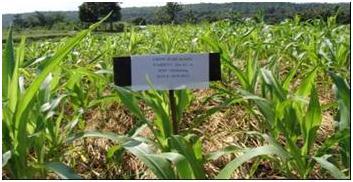
Rabi maize var. DA-61-A at vegetative stage
Seed production program for rice, maize, toria and linseed under the Tribal Sub-Plan (TSP): Under Tribal Sub-plan, quality seed production of maize, linseed and toria was initiated by ICAR Nagaland Centre Research Farm and farmers field (Vade village, Dimapur) during 2011-12 to till date. The total area was selected for maize seed production about 2.0 ha. A 15 quintal of quality seeds of maize (RCM-76) was produced to partially meet the requirement of quality seed for huge demand of maize farmers. Quality seeds of toria var. TS-36 and TS-38, TS- 67 and linseed var. Garima, Padmini and Sweta were also produced at Research Farm in an area of 1.0 ha of each.
Production potential of rainfed maize cultivars under moisture stress condition for climate resilient agriculture: Experiment was initiated at Research Farm in project 'National Initiative on Climate Resilient Agriculture”theme "Identification of temperature (drought/high temp.) tolerant rice and maize varieties for North-eastern hill ecosystem" in rabi season of 2010-12. Five maize varieties such as Nagaland local, Vijay composite, DA-61-A, DHM-117 and RCM-75 were grown to evaluate their suitability under moisture stress condition. The results revealed all the growth, yield attributes and yield of maize recorded higher with the treatment of RDF+FYM+Lime+Mulch. Among the variety, maize cv. RCM-76 recorded the highest grain yield but similar to RCM-75.
Validation of indigenous technical knowledge for weed management for sustainable production of jhum rice: The field experiment was initiated in the farmers' jhum field of Medziphema village, and treatment was consisted with ten different doses of common salt (20, 40, 60, 80, 100, 120, 140, 160, 180, and 200 kg/ha) at 20 and 40 DAS, weedy check and control (weedy) in randomized complete block design with three replications. The results clearly revealed that the soil organic carbon (SOC) content was increased in after harvest samples as compare to standing crop samples, which again decreased in after one year samples even lower than standing crop samples. On the contrary, available N, P and K content was decreased continuously during the crop growth period as well as jhum fallow period. The weedy check (T1) followed by 10 per cent salt application (T6) recorded the highest gross return (INR 48.02 and 44.57 × 103 ha-1) and net return (INR 27.47 and 26.27 ha-1) which was 44.3, 33.9 per cent and 54.9, 48.2 per cent higher than no salt application, respectively.
Breeding Programme to Harness the Gene Pool of Wonder Rice: Wonder rice is a rare species of paddy variety recognized by the Guinness Book of World Records as the tallest Paddy. For varietal improvement, three crosses were made using Shahsarang, RCM-20 and IET-17278 as male parents and wonder rice as female parentson, respectively.
Production potential of rainfed maize cultivars under moisture stress condition for climate resilient agriculture: Experiment was initiated at Research Farm in project 'National Initiative on Climate Resilient Agriculture”theme "Identification of temperature (drought/high temp.) tolerant rice and maize varieties for North-eastern hill ecosystem" in rabi season of 2010-12. Five maize varieties such as Nagaland local, Vijay composite, DA-61-A, DHM-117 and RCM-75 were grown to evaluate their suitability under moisture stress condition. The results revealed all the growth, yield attributes and yield of maize recorded higher with the treatment of RDF+FYM+Lime+Mulch. Among the variety, maize cv. RCM-76 recorded the highest grain yield but similar to RCM-75.
Validation of indigenous technical knowledge for weed management for sustainable production of jhum rice: The field experiment was initiated in the farmers' jhum field of Medziphema village, and treatment was consisted with ten different doses of common salt (20, 40, 60, 80, 100, 120, 140, 160, 180, and 200 kg/ha) at 20 and 40 DAS, weedy check and control (weedy) in randomized complete block design with three replications. The results clearly revealed that the soil organic carbon (SOC) content was increased in after harvest samples as compare to standing crop samples, which again decreased in after one year samples even lower than standing crop samples. On the contrary, available N, P and K content was decreased continuously during the crop growth period as well as jhum fallow period. The weedy check (T1) followed by 10 per cent salt application (T6) recorded the highest gross return (INR 48.02 and 44.57 × 103 ha-1) and net return (INR 27.47 and 26.27 ha-1) which was 44.3, 33.9 per cent and 54.9, 48.2 per cent higher than no salt application, respectively.
Breeding Programme to Harness the Gene Pool of Wonder Rice: Wonder rice is a rare species of paddy variety recognized by the Guinness Book of World Records as the tallest Paddy. For varietal improvement, three crosses were made using Shahsarang, RCM-20 and IET-17278 as male parents and wonder rice as female parentson, respectively.
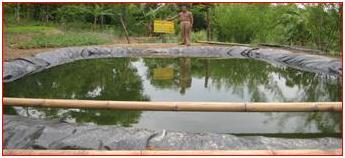
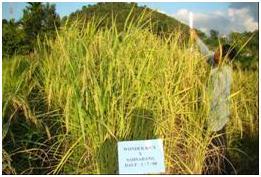
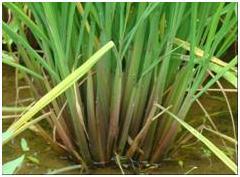
Soil and Water Conservation: Site-specific low-cost water harvesting structures (viz., Jalkund, base flow harvesting, rooftop rainwater harvesting, fish ponds, and Modified Thai Jar (for kitchen gardening) and soil erosion control measures (viz., contour and graded bunding, bench terracing, half-moon terracing, gully plugging, and trenching) were carried out in Dimapur, Peren, Wokha, Kohima, Phek and Mon districts of Nagaland for life saving irrigation, in-situ soil and moisture conservation. These works were undertaken under various projects, such as, Development of Non-forest Wastelands through Agro-forestry Models in Nagaland State of NEH Region, Integrated Watershed Development for Livelihood Security and Natural Resources Management, Livelihood Improvement and Empowerment of Rural Poor through Sustainable Farming Systems in Mon District of Nagaland, Horticulture Technology Mission, and National Initiative on Climate Resilient Agriculture.
Evaluation of Farming System Models: Under different projects, six numbers of farming system models (viz., Agri-silviculture, Agro-aquaculture, Agri-horticulture, Agri-horti-silviculture, Horti-pastoral, and Agri-horti-silvipastoral) were developed on sloppy areas of Mokokchung, Phek, Wokha, Dimapur, Peren, and Mon districts for long-term sustainable production. Among the models, Agri-horti-silvipastoral model was found most suitable land use system. Soil-erosion was minimized by 70% in farming system models.
Under NAIP scheme, various technological interventions on scientific pig, poultry and goat rearing; Water harvesting for multiple livelihood options; Terracing for wet rice cultivation; Rice and maize based cropping systems; Agro-forestry interventions including orchard establishment, Skill up-gradation have been undertaken in two clusters of Mon district, one of the most backward district of India recognized by the planning Commission, India.
Traditional method of ‘Echo’ being used by the farmers for soil conservation was improved upon through scientific methods using contour and graded bunding. The bunds were stabilized by planting the nitrogen fixing Tephrosia candida. In this system, the soil erosion could be controlled up to 42% than control.
Evaluation of Farming System Models: Under different projects, six numbers of farming system models (viz., Agri-silviculture, Agro-aquaculture, Agri-horticulture, Agri-horti-silviculture, Horti-pastoral, and Agri-horti-silvipastoral) were developed on sloppy areas of Mokokchung, Phek, Wokha, Dimapur, Peren, and Mon districts for long-term sustainable production. Among the models, Agri-horti-silvipastoral model was found most suitable land use system. Soil-erosion was minimized by 70% in farming system models.
Under NAIP scheme, various technological interventions on scientific pig, poultry and goat rearing; Water harvesting for multiple livelihood options; Terracing for wet rice cultivation; Rice and maize based cropping systems; Agro-forestry interventions including orchard establishment, Skill up-gradation have been undertaken in two clusters of Mon district, one of the most backward district of India recognized by the planning Commission, India.
Traditional method of ‘Echo’ being used by the farmers for soil conservation was improved upon through scientific methods using contour and graded bunding. The bunds were stabilized by planting the nitrogen fixing Tephrosia candida. In this system, the soil erosion could be controlled up to 42% than control.
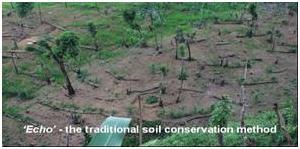
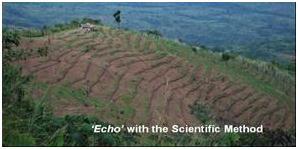
• Gmelina arborea, Tectona grandis, Terminalia myriocarpa, Multi-purpose tree species: Fruit trees: Psidium
guajava, Citrus reticulate, Litchi chinensis, Artocarpus heterophyllus, Musa paradisica, and Ananas squamos
etc were the most suitable agro-forestry spp. for developing different land use system.
• Rehabilitation of Degraded Wastelands: Rehabilitated a total of 500 ha of degraded waste lands through
Agroforestry interventions in Mokokchung, Phek, Wokha, Kohima, Dimapur, Peren, and Mon districts. pulses,
oilseeds, horticultural, fisheries and other economical crops.
• Network Project on Jatropha: Identified a total of 11 provenances of Jatropha and it was found that ‘Molvum’
genotype contains highest seed oil of 38.9%, followed by the genotypes of ‘Rangapahar’ (37.51%) and
‘Piphema’ (35.62%). Molvum source exhibited the highest growth rate in terms of height, followed by Piphema,
and Rangapahar seed source had the lowest growth. Diameter growth was recorded highest in Piphema
provenance, followed by Rűzaphema. Similar to the growth in height, no. of branches per plant were the highest
in Molvum (12.5 nos./plant), followed by Dhansiripar (10 nos./plant).
• To act as repository of agricultural information on net work for state regional
international market.
guajava, Citrus reticulate, Litchi chinensis, Artocarpus heterophyllus, Musa paradisica, and Ananas squamos
etc were the most suitable agro-forestry spp. for developing different land use system.
• Rehabilitation of Degraded Wastelands: Rehabilitated a total of 500 ha of degraded waste lands through
Agroforestry interventions in Mokokchung, Phek, Wokha, Kohima, Dimapur, Peren, and Mon districts. pulses,
oilseeds, horticultural, fisheries and other economical crops.
• Network Project on Jatropha: Identified a total of 11 provenances of Jatropha and it was found that ‘Molvum’
genotype contains highest seed oil of 38.9%, followed by the genotypes of ‘Rangapahar’ (37.51%) and
‘Piphema’ (35.62%). Molvum source exhibited the highest growth rate in terms of height, followed by Piphema,
and Rangapahar seed source had the lowest growth. Diameter growth was recorded highest in Piphema
provenance, followed by Rűzaphema. Similar to the growth in height, no. of branches per plant were the highest
in Molvum (12.5 nos./plant), followed by Dhansiripar (10 nos./plant).
• To act as repository of agricultural information on net work for state regional
international market.
IMPACT AND ACCEPTACE OF TECHNOLOGIES
Livelihood Improvement and Empowerment of Rural Poor through Sustainable Farming Systems in Mon District of Nagaland (NAIP): This project has been implemented in two most backward areas of Mon district, Lampong Sheanghah and Mon villages, identified by the Planning Commission of India. Based on the baseline survey, the main problems identified in the area include: Reduced Jhum cycle, thereby, sharp decline in crop yield; lack of quality seed and planting material; mono-cropping in rain-fed agriculture; poor socio-economic status of the people; lack of infrastructure facilities for increasing production; and poor quality of livestock, thereby, shortfall in animal protein production.
Livelihood Improvement and Empowerment of Rural Poor through Sustainable Farming Systems in Mon District of Nagaland (NAIP): This project has been implemented in two most backward areas of Mon district, Lampong Sheanghah and Mon villages, identified by the Planning Commission of India. Based on the baseline survey, the main problems identified in the area include: Reduced Jhum cycle, thereby, sharp decline in crop yield; lack of quality seed and planting material; mono-cropping in rain-fed agriculture; poor socio-economic status of the people; lack of infrastructure facilities for increasing production; and poor quality of livestock, thereby, shortfall in animal protein production.
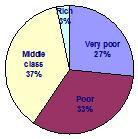
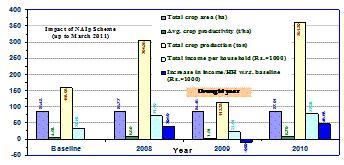
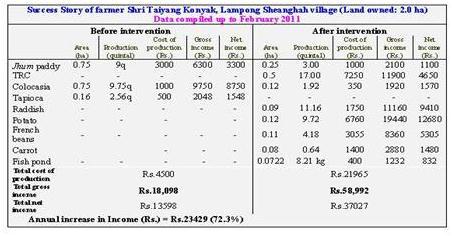
Terracing for wet rice cultivation or Panikheti has been executed covering an area of 7.2 ha. A total of 200 numbers of terraces were constructed having a net area of 5.8 ha. Quality seeds of rice, maize, french bean, pigeon pea, rice bean, radish, potato etc. were supplied to the farmers. Emphasis was given on nutritional kitchen gardening.
Introduction of water harvesting and its multiple uses for enhancing production has been proved to be very much beneficial for the farmers of the village. The system capacity for storing water for lean period was about 82.35 thousand litre. In order to irrigate the fields for an increased cropping intensity, particularly during lean season, two numbers of irrigation channels of 180 meter length, three channels lined with 70 ft GI pipe and 2600 ft PVC pipe have been constructed under this project. A rooftop rain water harvesting structure has also been constructed for domestic water supply meant for kitchen gardening. For integrated fish farming, three numbers of water harvesting structures have been constructed and two fish ponds were renovated. Emphasis has also been given for spring water harvesting and base flow harvesting.
Introduction of water harvesting and its multiple uses for enhancing production has been proved to be very much beneficial for the farmers of the village. The system capacity for storing water for lean period was about 82.35 thousand litre. In order to irrigate the fields for an increased cropping intensity, particularly during lean season, two numbers of irrigation channels of 180 meter length, three channels lined with 70 ft GI pipe and 2600 ft PVC pipe have been constructed under this project. A rooftop rain water harvesting structure has also been constructed for domestic water supply meant for kitchen gardening. For integrated fish farming, three numbers of water harvesting structures have been constructed and two fish ponds were renovated. Emphasis has also been given for spring water harvesting and base flow harvesting.
For scientific livestock rearing, two numbers of piggery units and integrated goat farming have been established. For backyard poultry rearing, a total of 1,530 numbers of 45-days old Kroiler birds were distributed to 5 numbers of SHGs of 80 households. After four months of rearing, farmers earned a net monetary benefit of `1,09,735.
For restoration of degraded lands through agro-forestry interventions, a total of 27,350 numbers of multipurpose tree species were planted covering an area of around 61.25 hectare of jhum land. Planting materials of 8 species, such as, Khokan, Nahar, Himalayan Alder, Titachap, Phulsap, Bonsum, Hollock, and Puma were planted. Contour and graded bunding, gully plugging, and half moon terracing were done for soil and water conservation. In the upland rice ecosystem, 8,940 numbers of fruit trees species, namely, Assam lemon; Khasi mandarin and Peach were planted under Agri- horti land use system.
Development of Non-forest Wastelands through Agro-forestry Models in Nagaland State of NEH Region: Under this project, a total of 500 ha of degraded waste lands were rehabilitated through different Agroforestry interventions in Mokokchung, Phek, Wokha, Kohima, Dimapur, Peren, and Mon districts. Technology was transferred through various farmers’ organizations, viz. Union of Co-operative Societies (UCOS) of Jalukie, Phek Farmers’ Association, Organic Growers’ Association of Molvum and Medziphema, Transforming Livelihood Intervention Society of Medziphema, RADS of Peren etc., NGOs (World Vision, Nandi Foundation), Naga Fragrance, Village Development Council, KVKs, and ATMA. The technology such as pineapple cultivation is well-accepted in the areas of Medziphema and Jalukie, whereas large cardamom orchards and kiwi plantation are abundantly practiced in Pfusro.
Development of Non-forest Wastelands through Agro-forestry Models in Nagaland State of NEH Region: Under this project, a total of 500 ha of degraded waste lands were rehabilitated through different Agroforestry interventions in Mokokchung, Phek, Wokha, Kohima, Dimapur, Peren, and Mon districts. Technology was transferred through various farmers’ organizations, viz. Union of Co-operative Societies (UCOS) of Jalukie, Phek Farmers’ Association, Organic Growers’ Association of Molvum and Medziphema, Transforming Livelihood Intervention Society of Medziphema, RADS of Peren etc., NGOs (World Vision, Nandi Foundation), Naga Fragrance, Village Development Council, KVKs, and ATMA. The technology such as pineapple cultivation is well-accepted in the areas of Medziphema and Jalukie, whereas large cardamom orchards and kiwi plantation are abundantly practiced in Pfusro.



